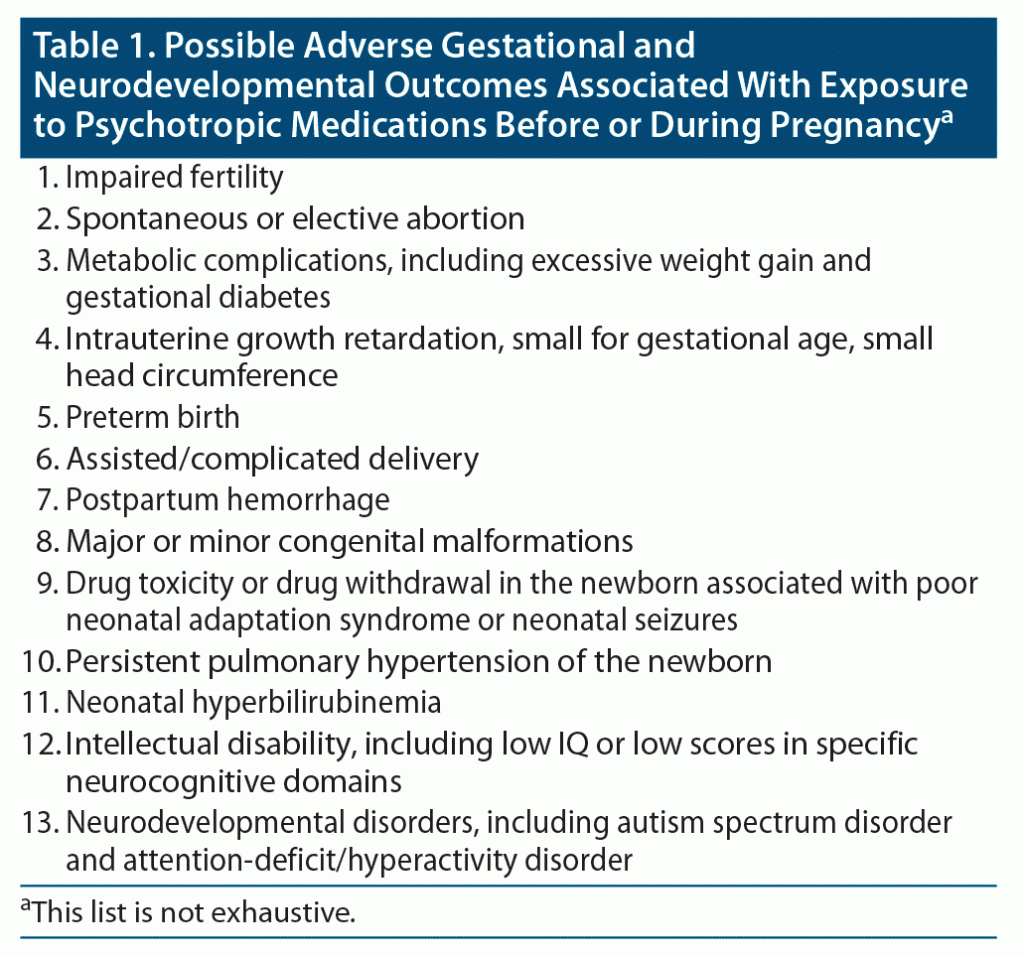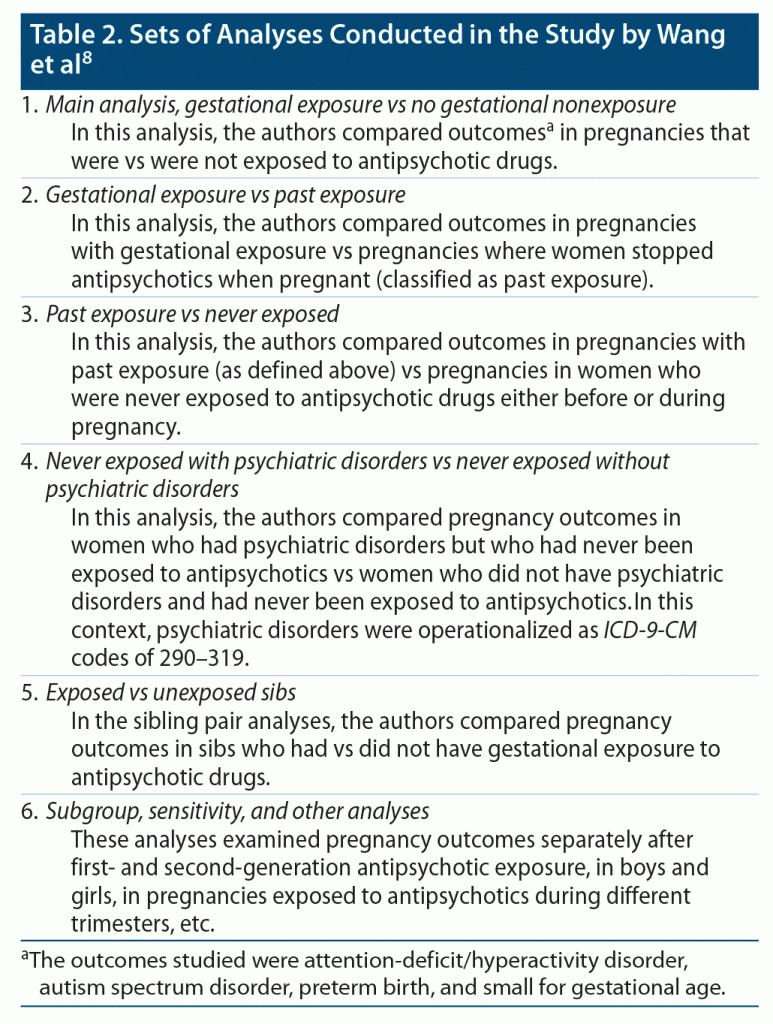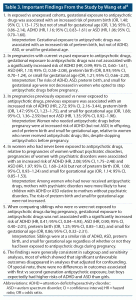ABSTRACT
Exposure to psychotropic drugs during pregnancy may adversely affect gestational and neurodevelopmental outcomes in many different ways. Much literature on the subject exists for antidepressant drug exposure. In contrast, the literature on antipsychotic drug exposure during pregnancy is relatively thin; this is a situation in which the underlying psychiatric disorder, the context of use, and the associated risks must all be understood. In this context, a large (n = 411,251 mother-child pairs), population-based, retrospective observational cohort study with 8–10 years of follow-up examined pregnancy (preterm birth, small for gestational age) and neurodevelopmental (attention-deficit/hyperactivity disorder [ADHD], autism spectrum disorder [ASD]) outcomes after gestational exposure to antipsychotic medications. The study found that, when exposed vs unexposed pregnancies were compared, gestational exposure to antipsychotics was associated with a small but significantly increased risk of preterm birth; there was no significant increase in the risk of small for gestational age, ADHD, or ASD. When pregnancies with gestational vs (only) pregestational (pre-pregnancy) exposure to antipsychotics were compared, and when exposed vs unexposed siblings were compared, gestational antipsychotic exposure was not associated with a significantly increased risk of any of these adverse outcomes. Pregnancies with only pregestational exposure were associated with all of the adverse outcomes (except ASD) relative to pregnancies in women with no antipsychotic exposure at any time. In antipsychotic-unexposed pregnancies, mothers with psychiatric disorders were more likely to have children with ADHD or ASD (but not preterm birth or small for gestational age) relative to mothers without psychiatric disorders. The findings of the study appear reassuring. However, there are many concerns about the study, some of which are potentially serious. The findings of the study should therefore be interpreted with caution, and decisions about antipsychotic use during pregnancy should continue to be made on a case-by-case basis, in consultation with the patient and her family. In most cases of women with major mental illness, the risk-benefit ratio is likely to favor continuation of antipsychotics during pregnancy.
J Clin Psychiatry 2021;82(5):21f14265
To cite: Andrade C. Gestational and neurodevelopmental outcomes associated with antipsychotic drug exposure during pregnancy. J Clin Psychiatry. 2021;82(5):21f14265.
To share: https://doi.org/10.4088/JCP.21f14265
© Copyright 2021 Physicians Postgraduate Press, Inc.
Exposure to psychotropic drugs during pregnancy may adversely affect gestational and neurodevelopmental outcomes; examples of possibilities are listed in Table 1. This subject has been extensively studied in the context of antidepressant drugs1 but not as well for antipsychotic drugs. A recently published systematic review and meta-analysis of 6 observational studies that included 2,515,272 pregnancies found a small increase in the risk of congenital malformations associated with antipsychotic exposure during pregnancy; the risk, however, did not reach statistical significance (risk ratio, 1.23; 95% confidence interval [CI], 0.96–1.58).2 Two very recent observational studies that were not included in this meta-analysis also suggested reproductive safety for antipsychotic drugs, except for a possible increase in malformation risk associated with olanzapine.3,4
Many observational studies have examined the risk of attention-deficit/hyperactivity disorder (ADHD) and autism spectrum disorder (ASD) after gestational exposure to antidepressant drugs; these studies were discussed in earlier articles in this column and elsewhere.1,5–7 In this context, Wang et al8 described a large population-based, retrospective, observational cohort study of pregnancy (preterm birth, small for gestational age) and neurodevelopmental (ADHD, ASD) outcomes after gestational exposure to antipsychotic medications.
The Study by Wang et al8
In this study, data were extracted from electronic medical records for children born in Hong Kong during 2001–2015 with follow-up to 2019; children with gestational exposure to antidepressant drugs or lithium were excluded because these drugs have been associated with adverse pregnancy and neurodevelopmental outcomes in some studies. There were 333,749 mother-child pairs for the ADHD analyses, of whom 547 (0.16%) were recorded to have had antipsychotic exposure during pregnancy; and 411,251 pairs (706; 0.17% exposed) for the preterm birth, small for gestational age, and ASD analyses. In these cohorts, the mean age of the mothers was about 31.6 years at the time of delivery. The mean duration of follow-up was about 10.4 years for the ADHD analyses and 8.3 years for the ASD analyses. Readers may note that the ADHD cohort was not an independent cohort. Rather, it was a subset that was carved out of the ASD, preterm birth, and small for gestational age cohort. This subset comprised subjects for whom a longer duration of follow-up (at least 6 years) was available, to allow for a later diagnosis of ADHD.
Preterm birth was defined as birth with < 37 weeks of gestation, and small for gestational age was defined as a birth weight that was 2 standard deviations or more below the population mean. ADHD and ASD were identified through ICD-9 codes, though diagnoses were believed to have been made based on DSM-5 criteria. ADHD was additionally identified through prescriptions for atomoxetine or methylphenidate. Exposed and unexposed groups, variously defined and composed (and hence overlapping, in many comparisons), were compared using Cox proportional hazard regression for the ADHD and ASD outcomes and using logistic regression for the preterm birth and small for gestational age outcomes. The groups being compared differed on a range of important confounding variables, and these were adjusted for using propensity score fine stratification weighting. The confounds included maternal age, socioeconomic status, infant sex, maternal medical and psychiatric illness, gestational and preexisting diabetes, and others.
The sample had 13,196 (3.95%) children with ADHD, 8,715 (2.12%) children with ASD, 33,891 (8.24%) children born preterm, and 7,009 (1.70%) children born small for gestational age. Many sets of analyses were conducted; these are detailed in Table 2.
Important findings from the study are presented in Table 3. In several of the unadjusted analyses, gestational exposure to antipsychotic drugs was significantly associated with many or all of the adverse outcomes. In adjusted analyses, however, most of the significant associations became nonsignificant.
In summary, in this observational, records-based study from Hong Kong, in the main analyses, when antipsychotic-exposed vs unexposed pregnancies were compared, gestational exposure to antipsychotic drugs was associated with a small (odds ratio, 1.40) but statistically significant increase in the risk of preterm birth; there was no significant increase in the risk of small for gestational age, or of ADHD or ASD across 8–10 years of follow-up. When pregnancies with gestational vs (only) pregestational (pre-pregnancy) exposure to antipsychotics were compared, and when exposed vs unexposed siblings were compared, gestational exposure to antipsychotics was not associated with a significant increase in the risk of any of these 4 adverse outcomes. Pregnancies with no gestational but only pregestational exposure were associated with all of the adverse outcomes (except ASD) relative to pregnancies in women who had never had antipsychotic exposure at any time. Mothers with psychiatric disorders were more likely to have children with ADHD or ASD (but not preterm birth or small for gestational age) relative to mothers without psychiatric disorders.
Interpretation of the Findings of the Study8
On the surface, the findings of the study are reassuring. Although no primary outcome was stated, and although no correction was made for type I (false-positive) statistical errors arising from multiple hypothesis testing, few analyses found significantly increased risks associated with gestational exposure to antipsychotic drugs. The discordant sibling pair analysis, which offered partial control for unmeasured and unknown genetic and shared environmental confounds, found that none of the 4 adverse outcomes studied were significantly associated with gestational antipsychotic exposure. In fact, it appeared that the risks of adverse outcomes were associated with the psychiatric illness rather than with antipsychotic drugs, as suggested by the findings of the current vs past exposure analyses and the analyses of the psychiatric vs no psychiatric disorders groups in never-exposed women.
The authors8 wrote that their findings suggest that women who need antipsychotics should not stop their medication during pregnancy because of a fear of the adverse outcomes examined in the study. These reassurances notwithstanding, there are many concerns about the study, some of which are serious. These concerns are discussed in the sections that follow.
Concerns About the Study8
Although the study sample appeared large (411,251 mother-child pairs), only 706 mother-child pairs had gestational antipsychotic drug exposure, and in the sibling-pair analyses, only 215 of 85,257 children were exposed. These numbers are rather small for sweeping generalizations about the safety or risks associated with antipsychotic drug exposure during pregnancy. Contrast these numbers, for example, with the numbers reported by a single pregnancy registry which, by April 2020, could report on 889 women who were prospectively studied for the reproductive safety of second-generation antipsychotic drugs.3
In a related context, many of the secondary, subgroup, and sensitivity analyses were probably underpowered. Examples are the trimester-wise analyses, the analyses for first- and second-generation antipsychotics separately, the analyses for boys and girls separately, and others. The authors did not analyze data by diagnosis (eg, for schizophrenia and mood disorders, separately); whereas this analysis would have been informative for clinical practice, it would probably also have been underpowered.
The authors reported that 72% of the exposed mothers had psychiatric disorders. So why were the remaining 28% prescribed antipsychotics; for conditions such as insomnia, tic disorder, or hyperemesis gravidarum? This (28%) is a large proportion of women treated with antipsychotic drugs for supposed nonpsychiatric indications during pregnancy. An even more puzzling finding is that only 0.9% of unexposed mothers had psychiatric disorders. A possible explanation is that women receiving antidepressants or lithium were excluded from the sample; so, for example, women with more severe anxiety or depression (who used these drugs during pregnancy) would have been excluded. However, there should have been a large number of women with milder anxiety and depression, and women with other psychiatric disorders, because the authors defined psychiatric disorders as all disorders with ICD-9-CM codes of 290–319; that is, the entire range of mental disorders. If these curiosities in the percentages were errors in the medical records or in the data extraction, then errors could have been present elsewhere in the study findings, as well.
The analyses of pregnancies of never exposed women with vs without psychiatric disorders may have been misleading on 2 counts: the psychiatric disorders in these analyses would very probably have been very different from the psychiatric disorders for which antipsychotic drugs are prescribed; and these women may have been treated for their psychiatric disorders with medications other than antipsychotics, antidepressants, or lithium, for which analyses were unadjusted.
The authors did not provide information about individual antipsychotic drugs. Whereas analyses for individual drugs would almost certainly have been underpowered, it would have been helpful for readers to know at least which antipsychotic drugs had been commonly used in the exposed pregnancies, and in what doses they had been prescribed. The findings of the study would best generalize to these drugs and doses. The authors did, however, indicate that 405 pregnancies had been exposed to first-generation antipsychotics alone, and 199 to second-generation antipsychotics alone. Given that the use of first-generation antipsychotics is declining, it could be difficult to generalize the findings of the study to current practice.
The authors did not adjust their analyses for body mass index, smoking, alcohol intake, illicit substance use, adherence to antipsychotic medication, and illness status during pregnancy. Certain of these (eg, active illness) could have biased the analyses toward worse outcomes, and certain of these (eg, poor medication adherence) could have biased the analyses toward the null hypothesis, exonerating antipsychotics from risk.
Although the authors adjusted for confounding to the extent possible, there is no way in which they could have adjusted for inadequately measured, unmeasured, and unknown confounds; some examples of these were listed in the previous paragraph. On the one hand, confounding by indication is likely to be associated with worse outcomes; this is because more severely ill women are more likely to continue medications during pregnancy, and greater severity of illness rather than medication use may predispose to adverse pregnancy outcomes. So, the absence of detection of unfavorable outcomes, despite incomplete adjustment for confounding, is reassuring. On the other hand, there could have been unmeasured confounds in the comparison groups that could have biased the findings toward the null hypothesis. For example, the women who discontinued antipsychotic treatment when pregnant (classified as past exposure) could have taken other psychotropic drugs or over the counter medications as medicinal substitutes that would help them better cope with illness-related symptoms during pregnancy. This concern also applies to the sibling-controlled analyses; the unexposed sibs could likewise have been exposed to other medications.
On a final note, coding for neurodevelopmental disorders in administrative databases may miss children who are affected but not diagnosed.
The Elephants in the Room
Women who “used antipsychotics before pregnancy but…discontinued receipt of treatment when pregnant”8 were classified as “past exposure”; additionally, these women may have been included under “gestationally unexposed” because there was overlap across comparison groups. Such classification is debatable because discontinuation of antipsychotic treatment only when pregnancy was discovered implies that there was some antipsychotic exposure during early pregnancy. Therefore, all analyses that included (as controls) women so classified would be biased toward the null hypotheses that suggest an absence of risk associated with gestational antipsychotic exposure. An additional problem is that such women may have taken other psychotropic drugs, or over-the-counter medications, to cope with illness symptoms during pregnancy. If treatments with unknown safety were used during pregnancy, this would also bias the results toward the null hypothesis.
The authors adjusted for gestational diabetes, recorded in 19.2% vs 11.5% of exposed vs unexposed pregnancies. On the surface, this appears to be important and necessary because gestational diabetes has been associated with adverse pregnancy outcomes, and particularly because gestational diabetes is associated with large for gestational age, which may mask the ability of the study analyses to detect an antipsychotic exposure effect on small for gestational age.9 However, antipsychotic drug exposure during pregnancy increases the risk of gestational diabetes,10 and gestational diabetes has also been associated with neurodevelopmental disorder11; so, to adjust for gestational diabetes would remove a mechanism by which gestational antipsychotic exposure might affect neurodevelopment. This would bias the results of the analyses toward the null hypothesis.
Take-Home Message
What can we conclude? On the one hand, the findings of this study8 were largely reassuring: unfavorable gestational and neurodevelopmental outcomes were associated with psychiatric disorders rather than with antipsychotic drug exposure during pregnancy. On the other hand, because of the many shortcomings in the analyses, risks associated with gestational antipsychotic exposure cannot be ruled out. The findings of the study should therefore be interpreted with caution and decisions should be made on a case-by-case basis, in consultation with the patient and her family. If antipsychotic medications are stopped, there is a high risk of relapse into major mental illness with potentially serious consequences for mental and physical health and functioning in family, social, and other domains. If antipsychotic medications are continued during pregnancy, there is a possible small theoretical risk of adverse gestational and neurodevelopmental consequences. The decision to stop or continue is not easy.12
Published online: October 12, 2021.
 Each month in his online column, Dr Andrade considers theoretical and practical ideas in clinical psychopharmacology with a view to update the knowledge and skills of medical practitioners who treat patients with psychiatric conditions.
Each month in his online column, Dr Andrade considers theoretical and practical ideas in clinical psychopharmacology with a view to update the knowledge and skills of medical practitioners who treat patients with psychiatric conditions.
Department of Clinical Psychopharmacology and Neurotoxicology, National Institute of Mental Health and Neurosciences, Bangalore, India ([email protected]).
Financial disclosure and more about Dr Andrade.
References (12)

- Rommel AS, Bergink V, Liu X, et al. Long-term effects of intrauterine exposure to antidepressants on physical, neurodevelopmental, and psychiatric outcomes: a systematic review. J Clin Psychiatry. 2020;81(3):19r12965. PubMed CrossRef
- Wang Z, Brauer R, Man KKC, et al. Prenatal exposure to antipsychotic agents and the risk of congenital malformations in children: a systematic review and meta-analysis. Br J Clin Pharmacol. 2021;bcp.14839. PubMed CrossRef
- Viguera AC, Freeman MP, Góez-Mogollón L, et al. Reproductive safety of second-generation antipsychotics: updated data from the Massachusetts General Hospital National Pregnancy Registry for atypical antipsychotics. J Clin Psychiatry. 2021;82(4):20m13745. PubMed CrossRef
- Ellfolk M, Leinonen MK, Gissler M, et al. Second-generation antipsychotic use during pregnancy and risk of congenital malformations. Eur J Clin Pharmacol. 2021. PubMed CrossRef
- Andrade C. Antidepressant exposure during pregnancy and risk of autism in the offspring, 1: meta-review of meta-analyses. J Clin Psychiatry. 2017;78(8):e1047–e1051. PubMed CrossRef
- Andrade C. Antidepressant exposure during pregnancy and risk of autism in the offspring, 2: do the new studies add anything new? J Clin Psychiatry. 2017;78(8):e1052–e1056. PubMed CrossRef
- Uguz F. Maternal antidepressant use during pregnancy and the risk of attention-deficit/hyperactivity disorder in children: a systematic review of the current literature. J Clin Psychopharmacol. 2018;38(3):254–259. PubMed CrossRef
- Wang Z, Chan AYL, Coghill D, et al. Association between prenatal exposure to antipsychotics and attention-deficit/hyperactivity disorder, autism spectrum disorder, preterm birth, and small for gestational age. JAMA Intern Med. 2021. PubMed CrossRef
- Wendland EM, Torloni MR, Falavigna M, et al. Gestational diabetes and pregnancy outcomes: a systematic review of the World Health Organization (WHO) and the International Association of Diabetes in Pregnancy Study Groups (IADPSG) diagnostic criteria. BMC Pregnancy Childbirth. 2012;12(1):23. PubMed CrossRef
- Wang Z, Wong ICK, Man KKC, et al. The use of antipsychotic agents during pregnancy and the risk of gestational diabetes mellitus: a systematic review and meta-analysis. Psychol Med. 2021;51(6):1028–1037. PubMed CrossRef
- Rowland J, Wilson CA. The association between gestational diabetes and ASD and ADHD: a systematic review and meta-analysis. Sci Rep. 2021;11(1):5136. PubMed CrossRef
- Burt VK, Rasminsky S. No simple decisions for psychiatrically ill pregnant women. J Clin Psychiatry. 2021;82(4):21com14044. PubMed CrossRef
This PDF is free for all visitors!








